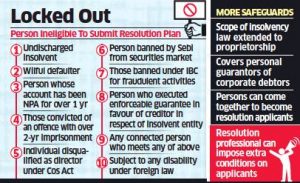Introduction:
Scenario upto the year 2000 –
A person was able to seek loan from one lender and default repayment thereof. Then he would approach another lender and again obtain a new loan without the new lender realising that the borrower has already defaulted on repaying loan from another lender. And the game would go on and on.
Scenario between from the year 2000 to 2016 –
The Reserve Bank of India found it necessary to create an adequate, comprehensive and reliable information system which will collect and maintain a database of borrowers. Hence, after many discussions and recommendations, Credit Information Bureau (India) Ltd., (CIBIL) was set up in January 2000 was formed.
Scenario from the year 2016 –
After information was collated by CIBIL, lending to defaulters stopped. However recovery thereof was a time consuming and lengthy process leading to meagre recoveries compared to the efforts put in. Recognising that reforms in the bankruptcy and insolvency regime are critical for improving the business environment and alleviating distressed credit markets, Insolvency and Bankruptcy Code can be said as India’s ‘Bread’ code for lenders saddled with ‘Dough’ being Non-performing Assets. The Insolvency and Bankruptcy Code, 2016 (IBC) (enacted in May, 2016) seeks to consolidate the existing framework by creating a single law for insolvency and bankruptcy. The legal and institutional framework before this Code did not aid lenders in effective and timely recovery or restructuring of defaulted assets and causes undue strain on the Indian credit system. The Code which outlines separate insolvency resolution processes for individuals, companies and partnership firms.
Distinctive features
- Comprehensive law
- Withering away multiplicity of laws
- Low Time Resolution – Completion of the insolvency resolution process for companies will have to be completed in 180 days, which may be extended by 90 days, if a majority of the creditors agree and for start-ups (other than partnership firms), small companies and other companies (with asset less than Rs. 1 crore), resolution process would be completed within 90 days of initiation of request which may be extended by 45 days.
- One window clearance
- Clarity in Process – There is a clear and unambiguous process to be followed by all stakeholders. There is also shift of control from shareholders and promoters to creditors.
- One Chain of Authority – It does not even allow the Civil Courts to interfere with the application pending before the adjudicating authority, thereby reducing the multiplicity of litigations. The National Company Law Tribunal (NCLT) will adjudicate insolvency resolution for companies. The Debt Recovery Tribunal (DRT) will adjudicate insolvency resolution for individuals.
- Protects the Interests of Workmen and Employees
- New Regulatory Authority being Insolvency and Bankruptcy Board of India.
- Establishment of Information Utilities which are intended to function as a databank to collect, collate and disseminate financial information and to facilitate insolvency resolution.
Since its implementation, there was hue and cry about certain shortcomings in the Code – to name a few- unquestionable word of the lenders, prohibition to withdraw application once admitted, too much powers to Insolvency Professional (IP), defaulters bidding for the assets and in case lenders fail to arrive as a consensus then liquidation of the Company is the only alternative.
Through ordinance the President of India has addressed one of the short coming of the code preventing defaulters from bidding for their assets in resolution proceedings and regaining control while banks were forced to swallow losses.
In a nutshell the other amendments are listed below

NPowersU Expert Opinion
In our view the most important shortcoming of the code is addressed which would otherwise have permitted the defaulters to gain access through back door entry and will encourage private investors (domestic and global) to come forward and bid for distressed assets as the fear of meddling promoters is substantially reduced. As is prevalent in our Country, new law has loose ends so that matters can be decided by courts on litigation. This is one more example of not-so-perfect drafted law. Further not all promoters are willful defaulters as their business might have been affected by unfavorable business or cyclical fluctuations. But they cannot cry foul. Future of willful and other defaulters is bleak where law is taking its own course. Yes, lenders may be upset as there is a possibility that in absence of promoters during the bidding process, non-promoter bidders will look for distress valuation. In our view these are bookish fears and bidding will be based on demand and supply leading to true price of the distressed assets.
Related Link:

